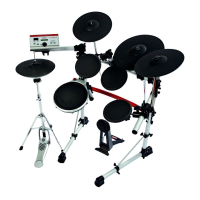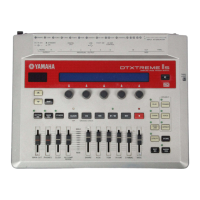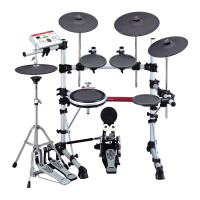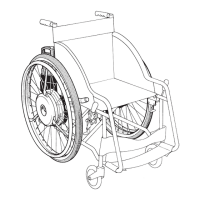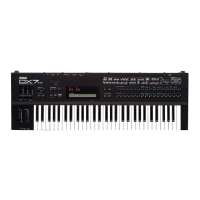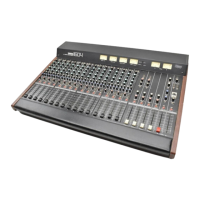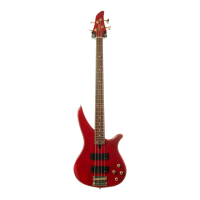Do you have a question about the Yamaha II and is the answer not in the manual?
Information regarding the product's battery, including warnings and handling.
Guidelines for the proper disposal of the product and its components.
Details on where to find the product's identification and specification plate.
Regulatory compliance information for the product in the USA.
Warnings and guidelines for using the power adapter and connecting to power.
Safety warnings regarding exposure to water and fire hazards.
Guidelines for cleaning, general usage, and avoiding damage.
Details about the internal backup battery and its implications.
Overview of the DTXPLORER's 9 trigger inputs and 1 hi-hat controller.
Details on the 16-bit AWM2 32-voice sound engine and voice types.
Description of the metronome's adjustable features like tempo and timing.
Information on the 22 built-in songs for practice and accompaniment.
Feature for analyzing and improving playing accuracy and consistency.
Overview of the various input and output connectors on the module.
Identification and function of buttons, display, and controls on the top panel.
Identification and function of all ports and connectors on the rear panel.
Instructions on how to connect drum pads to the trigger input jacks.
Guidance on compatibility and use with acoustic drum setups.
Details on connecting specific pads and devices like stereo headphones.
Instructions for connecting to mixers, audio equipment, and recording devices.
Information on using the MIDI OUT port for external sound module control.
Instructions and warnings for connecting the AC adapter and powering the unit.
Essential steps to take before turning on the DTXPLORER and connected devices.
How to choose and cycle through the 32 preset and user-defined drum kits.
Using the Master Equalizer to adjust the overall sound output.
Customizing the hi-hat controller's open and closed sound behavior.
How to turn the metronome on and off.
Configuring metronome parameters like tempo, beat, and click sound volume.
Designing and storing personalized metronome sound patterns.
Procedure for saving user-created metronome settings.
Routing the metronome sound to specific output jacks.
Choosing from the 22 built-in songs for practice.
Controlling playback speed and volume for accompaniment songs.
Feature to mute the drum section of a song for practice.
Practice mode focusing on the bass line of songs.
Setting the tempo by tapping a pad or button.
Choosing a song or metronome for timing analysis.
How to enter the Groove Check mode and its settings.
Choosing which pads to analyze for timing accuracy.
Defining the reference note value for timing evaluation.
Adjusting the sensitivity threshold for trigger detection.
Initiating the groove check process with playback.
Guidance on how to interpret timing feedback and improve performance.
Choosing a base kit to customize from preset or user memories.
Selecting specific drum sounds for each pad input.
Adjusting the volume level for individual drum sounds.
Modifying the pitch of individual drum sounds.
Adjusting the stereo position (left/right) of drum sounds.
Selecting the type of reverb effect to apply to the kit.
Adjusting the sustain time of drum sounds.
Modifying the filter settings to alter sound tone.
Configuring sound muting and switching behavior between sounds.
Procedure for saving your custom drum kit creations.
Steps to restore the DTXPLORER to its original factory default settings.
Choosing from pre-configured trigger setting types or custom presets.
Detailed parameter adjustments for individual trigger inputs.
Specifying the type of drum pad connected for optimal performance.
Setting input sensitivity (gain) and minimum velocity.
Adjusting how velocity changes affect the sound output.
Parameter to prevent double triggering by setting a brief quiet period.
Setting a threshold to prevent crosstalk from adjacent triggers.
Fine-tuning rejection for specific input jack combinations.
Duplicating trigger settings from one input to another.
Troubleshooting steps for the 'Data Initialized' error message.
Explanation of the 'Battery Low' warning and its implications.
Diagnosing issues when no sound is produced or triggers are not recognized.
Resolving problems with external audio devices connected to the unit.
Addressing issues where sounds are too quiet or lack impact.
Troubleshooting inconsistent or erratic trigger responses.
Resolving the problem of a single hit producing two sounds.
Preventing unwanted trigger signals from adjacent pads.
Diagnosing issues where only one pad sound is heard.
Addressing problems where sounds are excessively loud.
Troubleshooting when the unit fails to register trigger or switch inputs.
Resolving issues where sounds play continuously or intermittently.
Specific troubleshooting for the closed hi-hat sound not being heard.
Details on the sound engine, polyphony, and available drum/voice types.
Specifications for trigger configurations and the sequencer.
Information on the physical controls and the LCD display.
Specifications for input/output ports and power requirements.
Product size, weight, and included accessories.
Description of MIDI channel messages sent by drum triggers.
Details on system-exclusive MIDI messages for parameter changes.
Information on MIDI realtime messages like timing clock and start/stop.
Overview of the initial display screens shown upon power-on.
Visual guide to the displays related to drum kit configuration.
Display interface for selecting and previewing songs.
Overview of the displays for system utility and configuration settings.
Visual representation of the metronome setup and adjustment screens.
Displays detailing the various trigger parameter editing options.
Screens related to the optimal timing check and groove analysis.
The display interface for setting tempo via the tap tempo feature.
Categorized lists of available drum sounds, including Kick, Snare, Tom, Cymbal, etc.
Information regarding the product's battery, including warnings and handling.
Guidelines for the proper disposal of the product and its components.
Details on where to find the product's identification and specification plate.
Regulatory compliance information for the product in the USA.
Warnings and guidelines for using the power adapter and connecting to power.
Safety warnings regarding exposure to water and fire hazards.
Guidelines for cleaning, general usage, and avoiding damage.
Details about the internal backup battery and its implications.
Overview of the DTXPLORER's 9 trigger inputs and 1 hi-hat controller.
Details on the 16-bit AWM2 32-voice sound engine and voice types.
Description of the metronome's adjustable features like tempo and timing.
Information on the 22 built-in songs for practice and accompaniment.
Feature for analyzing and improving playing accuracy and consistency.
Overview of the various input and output connectors on the module.
Identification and function of buttons, display, and controls on the top panel.
Identification and function of all ports and connectors on the rear panel.
Instructions on how to connect drum pads to the trigger input jacks.
Guidance on compatibility and use with acoustic drum setups.
Details on connecting specific pads and devices like stereo headphones.
Instructions for connecting to mixers, audio equipment, and recording devices.
Information on using the MIDI OUT port for external sound module control.
Instructions and warnings for connecting the AC adapter and powering the unit.
Essential steps to take before turning on the DTXPLORER and connected devices.
How to choose and cycle through the 32 preset and user-defined drum kits.
Using the Master Equalizer to adjust the overall sound output.
Customizing the hi-hat controller's open and closed sound behavior.
How to turn the metronome on and off.
Configuring metronome parameters like tempo, beat, and click sound volume.
Designing and storing personalized metronome sound patterns.
Procedure for saving user-created metronome settings.
Routing the metronome sound to specific output jacks.
Choosing from the 22 built-in songs for practice.
Controlling playback speed and volume for accompaniment songs.
Feature to mute the drum section of a song for practice.
Practice mode focusing on the bass line of songs.
Setting the tempo by tapping a pad or button.
Choosing a song or metronome for timing analysis.
How to enter the Groove Check mode and its settings.
Choosing which pads to analyze for timing accuracy.
Defining the reference note value for timing evaluation.
Adjusting the sensitivity threshold for trigger detection.
Initiating the groove check process with playback.
Guidance on how to interpret timing feedback and improve performance.
Choosing a base kit to customize from preset or user memories.
Selecting specific drum sounds for each pad input.
Adjusting the volume level for individual drum sounds.
Modifying the pitch of individual drum sounds.
Adjusting the stereo position (left/right) of drum sounds.
Selecting the type of reverb effect to apply to the kit.
Adjusting the sustain time of drum sounds.
Modifying the filter settings to alter sound tone.
Configuring sound muting and switching behavior between sounds.
Procedure for saving your custom drum kit creations.
Steps to restore the DTXPLORER to its original factory default settings.
Choosing from pre-configured trigger setting types or custom presets.
Detailed parameter adjustments for individual trigger inputs.
Specifying the type of drum pad connected for optimal performance.
Setting input sensitivity (gain) and minimum velocity.
Adjusting how velocity changes affect the sound output.
Parameter to prevent double triggering by setting a brief quiet period.
Setting a threshold to prevent crosstalk from adjacent triggers.
Fine-tuning rejection for specific input jack combinations.
Duplicating trigger settings from one input to another.
Troubleshooting steps for the 'Data Initialized' error message.
Explanation of the 'Battery Low' warning and its implications.
Diagnosing issues when no sound is produced or triggers are not recognized.
Resolving problems with external audio devices connected to the unit.
Addressing issues where sounds are too quiet or lack impact.
Troubleshooting inconsistent or erratic trigger responses.
Resolving the problem of a single hit producing two sounds.
Preventing unwanted trigger signals from adjacent pads.
Diagnosing issues where only one pad sound is heard.
Addressing problems where sounds are excessively loud.
Troubleshooting when the unit fails to register trigger or switch inputs.
Resolving issues where sounds play continuously or intermittently.
Specific troubleshooting for the closed hi-hat sound not being heard.
Details on the sound engine, polyphony, and available drum/voice types.
Specifications for trigger configurations and the sequencer.
Information on the physical controls and the LCD display.
Specifications for input/output ports and power requirements.
Product size, weight, and included accessories.
Description of MIDI channel messages sent by drum triggers.
Details on system-exclusive MIDI messages for parameter changes.
Information on MIDI realtime messages like timing clock and start/stop.
Overview of the initial display screens shown upon power-on.
Visual guide to the displays related to drum kit configuration.
Display interface for selecting and previewing songs.
Overview of the displays for system utility and configuration settings.
Visual representation of the metronome setup and adjustment screens.
Displays detailing the various trigger parameter editing options.
Screens related to the optimal timing check and groove analysis.
The display interface for setting tempo via the tap tempo feature.
Categorized lists of available drum sounds, including Kick, Snare, Tom, Cymbal, etc.
| Shell Material | Birch |
|---|---|
| Bass Drum Size | 22" x 17" |
| Snare Drum Size | 14" x 5.5" |
| Tom Sizes | 16" x 16" |
| Hardware Included | Yes |
